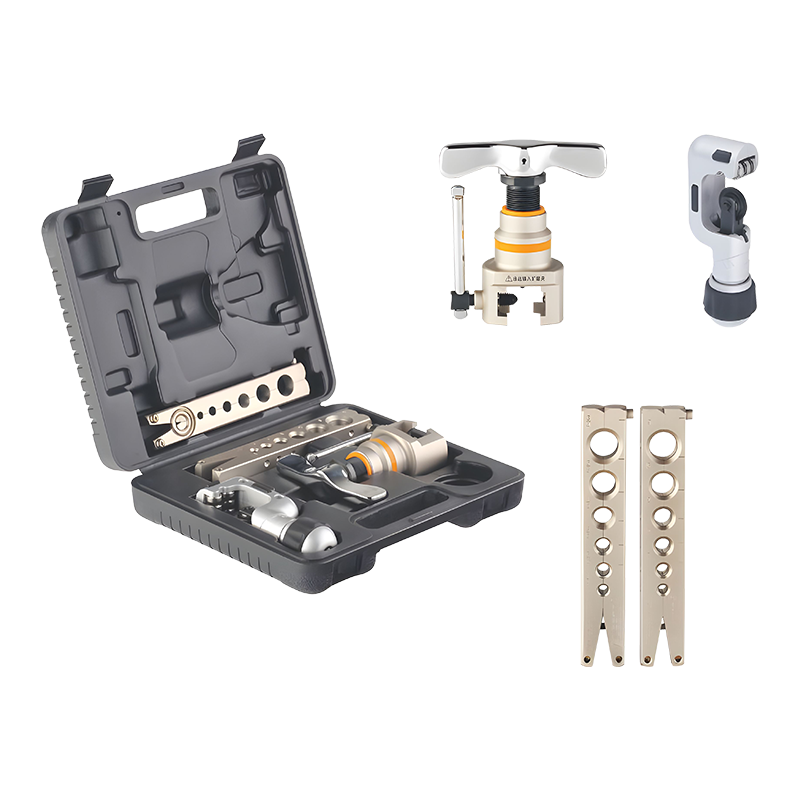Aug 15, 2025
The flaring and pipe cutting tool set generally includes a pipe cutter, a flaring bar, and a flaring cone or yoke. Some sets may include deburring tools or reamers, as well as adaptors to accommodate a variety of pipe sizes. Each tool in the flaring and pipe cutting tool set serves a distinct purpose, but they are often used in sequence during installation or repair tasks.

The pipe cutter in a flaring and pipe cutting tool set is used to create clean, square cuts in metal tubing, commonly copper, aluminum, or steel. This is a necessary step before flaring, as a straight, even cut is critical for forming a reliable flare. The cutter typically uses a rotary cutting wheel that is pressed against the pipe and rotated around it, gradually tightening until the pipe is severed. In some advanced flaring and pipe cutting tool set models, the pipe cutter includes adjustable rollers and a built-in reamer.
The flaring tool itself is used after the pipe has been cut. The user inserts the freshly cut pipe into the flaring bar, clamps it securely, and aligns the end of the pipe to the correct position. Then, using a flaring cone or yoke, the tool presses into the pipe end, forming a flare. This flare is a widened, conical section at the pipe's edge, allowing it to fit snugly into a mating surface. In many systems, this provides a sealed, pressure-tight connection, especially in applications like fuel lines or refrigeration tubing.
A flaring and pipe cutting tool set is designed to handle different sizes of tubing. Many sets include multiple holes in the flaring bar to accommodate various pipe diameters. The pipe cutter may also be adjustable to work with the same range of sizes. This versatility is one of the strengths of a flaring and pipe cutting tool set, enabling it to be used in multiple trades and project types without the need for specialized equipment.
One important difference within a flaring and pipe cutting tool set lies in the types of flares that can be made. The two common flare types are 45-degree flares and double flares. A standard 45-degree flare is used in plumbing and HVAC applications, while a double flare, often used in automotive brake systems, provides additional strength by folding the pipe's edge back on itself before flaring. Some flaring and pipe cutting tool sets are capable of producing both flare types, while others are limited to one. It's essential to know which is required for the application before selecting a specific flaring and pipe cutting tool set.
In terms of material compatibility, a flaring and pipe cutting tool set is typically designed for soft metals. While some heavy-duty sets may work on stainless steel, many are intended for copper, aluminum, or mild steel. Attempting to use a standard flaring and pipe cutting tool set on hardened steel can damage the tools and produce poor-quality results. For such applications, specialized sets with hardened steel components are required.
Ease of use is another consideration when comparing different flaring and pipe cutting tool sets. Some sets feature wing nuts or quick-release mechanisms for faster operation. Others have graduated guides or depth stops to help ensure consistent flaring. In professional environments, a flaring and pipe cutting tool set with ergonomic features and robust construction will generally be preferred for its reliability under frequent use.
The quality of the flare produced by a flaring and pipe cutting tool set directly affects the reliability of the system being assembled. A poorly formed flare can leaks, pressure loss, or even system failure. Therefore, precision and proper alignment are critical. Many tool sets now include guides or markings to assist users in aligning the pipe and the flaring cone correctly.